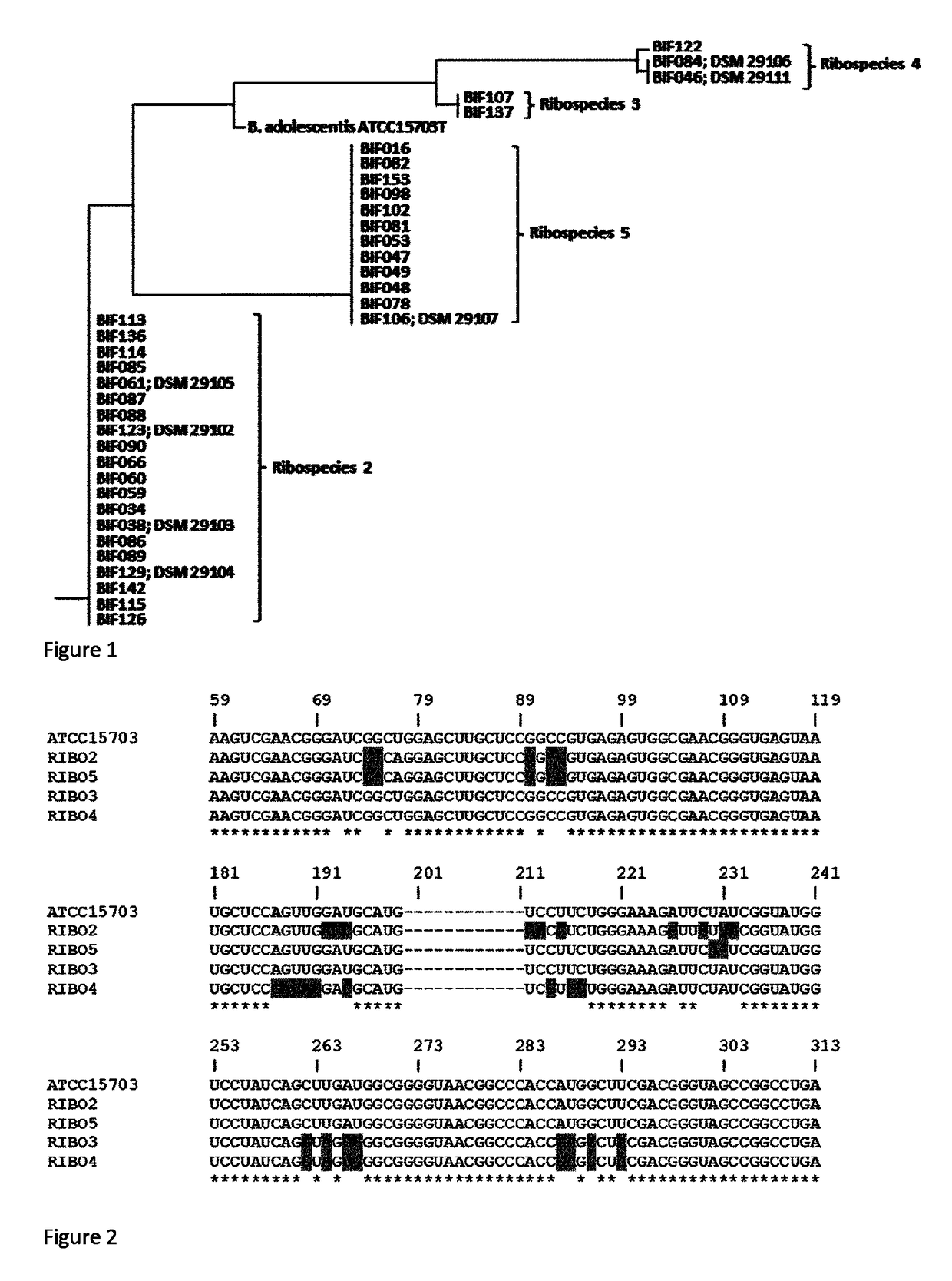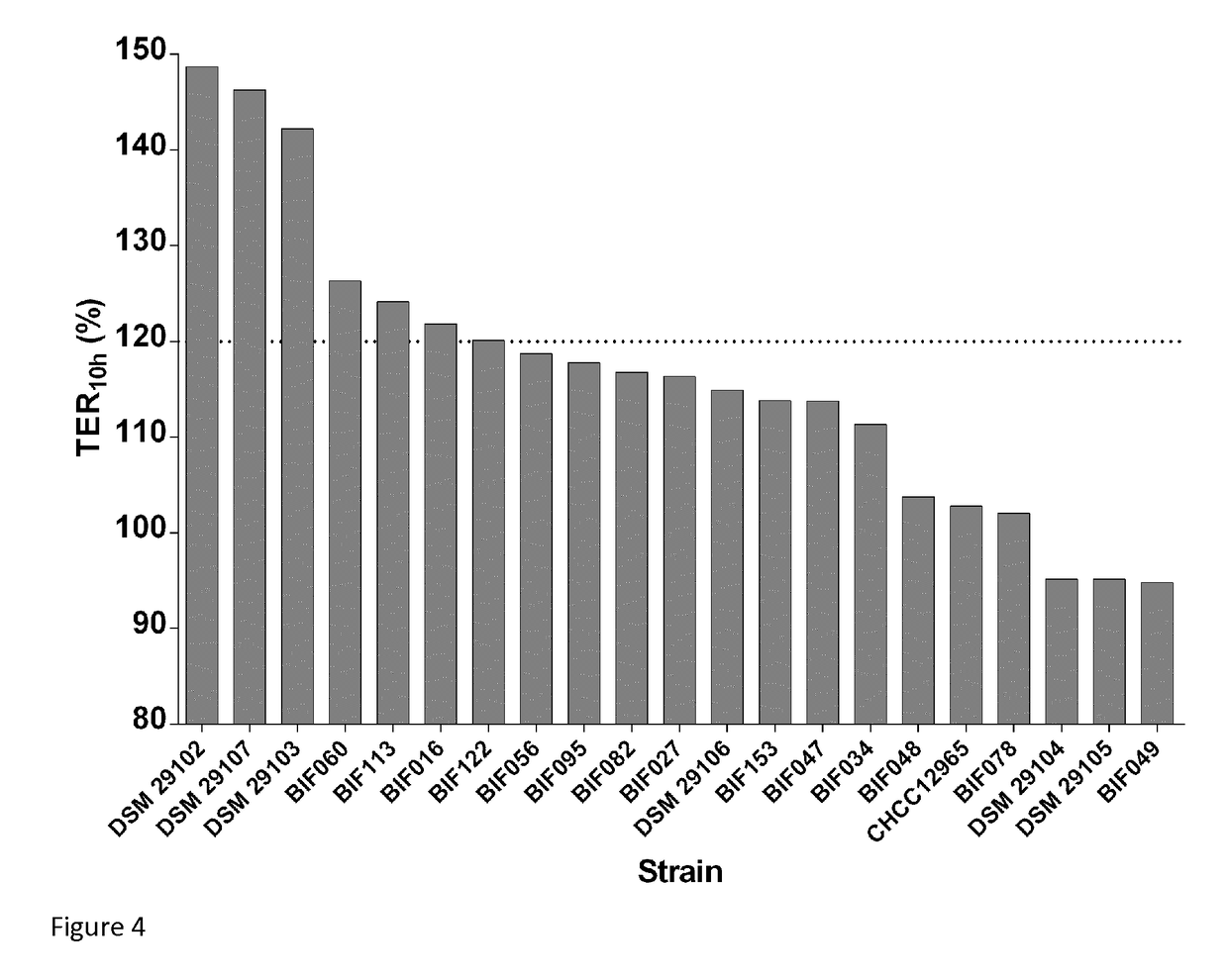Probiotic Bifidobacterium adolescentis strains
a technology of bifidobacterium adolescentis and probiotics, which is applied in the field of new isolated strains of bifidobacterium adolescentis, can solve the problem that the method is not able to unambiguously discriminate unique taxons, and achieve the effects of reducing colitis severity, reducing disease severity, and effectively inhibiting disease severity
- Summary
- Abstract
- Description
- Claims
- Application Information
AI Technical Summary
Benefits of technology
Problems solved by technology
Method used
Image
Examples
example 1
of Bifidobacteria from Healthy Humans
[0159]Bifidobacteria were isolated from frozen (−80° C.) human stool samples collected from healthy volunteers. Written consent to utilize the material for bacterial isolation was obtained from all volunteers. Samples were thawed and 4 g of sample was mixed in a stomacher at high-speed in 35 ml peptone saline with 0.05% cysteine chloride. After thorough mixing, 10-fold serial dilutions were made in peptone saline. One hundred μl aliquots were plated from 105, 106, 107, 108, and 109 dilutions on Tomato juice / Eugon agar pH 7.0; (Tomato juice, pH adjusted to 7.0 (400 mL / 1000 mL), 45 g Eugon agar (Difco) / 1000 mL, 1% maltose, 0.05% cysteine chloride, 0.0005% haemin, 40 mg / 1000 mL X-gal (5-bromo-4-chloro-3-indolyl-β-D-galactopyranoside)), and Columbia medium pH 7.0 (adjusted Beerens medium) agar; (Columbia medium (Difco), 0.005% glucose, 0.1% propionic acid sodium salt, 0.05% cysteine chloride, 40 mg X-gal.
[0160]Plates were incubated anaerobically at 3...
example 2
Sequencing and Phylogenetic Analysis
[0163]Partial 16S rRNA gene sequences were determined by amplification of part of the 16S rDNA with conserved primers 616V (5′-AGRGTTTGATYCKGGCTCAG-3′) and 612R (5′-GTAAGGTICITCGCGT-3′) and subsequent sequencing of the amplification product with conserved primer 610R (5′-ACCGCGGCTGCTGGCAC-3′). Sanger sequencing reactions were performed by LGC Genomics, Berlin, Germany).
[0164]Partial 16S rDNA sequences (E. coli position 27 to 468; Brosius et al 1978) from the isolated Bifidobacterium strains and B. adolescentis ATCC 15703T were aligned using Clustal Omega (http: / / www.ebi.ac.uk / Tools / msa / clustalo / ). A phylogenetic tree file was generated by neighbour joining using ClustalW2-Phylogeny (http: / / www.ebi.ac.uk / Tools / phylogeny / clustalw2_phylogeny / ), and the tree displayed using the Phylodendron Phylogenetic tree printer (http: / / iubio.bio.indiana.edu / treeapp / treeprint-form.html).
[0165]Results
[0166]Thirty-six Bifidobacterium strains were most closely relate...
example 3
eassociation
[0169]DNA-DNA relatedness of a collection of B. adolescentis-like strains to Bifidobacterium type strains was determined by BCCM™ / LMG, Bacteria Collection Laboratorium voor Microbiologic Universiteit Gent.
[0170]The following cultures were investigated BIF122, DSM 29103 (BIF038), DSM 29107 (BIF106), BIF107, B. adolescentis LMG 10502T, B. stercoris LMG 27438T, B. ruminantium LMG 21811T, B. dentium LMG 11045T, and B. angulatum LMG 11039T. These species are all affiliated with the B. adolescentis group.
[0171]Bacteria were cultured on LMG medium 144, and checked for purity after incubation at 37° C. under anaerobic conditions. Genomic DNA was extracted according to a modification of the procedure of Gevers et al. (2001). Hybridizations were performed in the presence of 50% formamide at 49° C. according to a modification (Gulls et al., 1998; Cleenwerck et al., 2002) of the method described by Ezaki et al. (1989). Reciprocal reactions (A×B and B×A) were performed and the differ...
PUM
| Property | Measurement | Unit |
|---|---|---|
| time | aaaaa | aaaaa |
| pore size | aaaaa | aaaaa |
| pore size | aaaaa | aaaaa |
Abstract
Description
Claims
Application Information
 Login to View More
Login to View More - R&D
- Intellectual Property
- Life Sciences
- Materials
- Tech Scout
- Unparalleled Data Quality
- Higher Quality Content
- 60% Fewer Hallucinations
Browse by: Latest US Patents, China's latest patents, Technical Efficacy Thesaurus, Application Domain, Technology Topic, Popular Technical Reports.
© 2025 PatSnap. All rights reserved.Legal|Privacy policy|Modern Slavery Act Transparency Statement|Sitemap|About US| Contact US: help@patsnap.com



